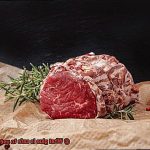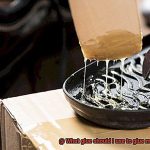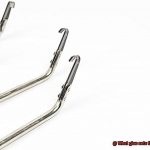Resin art, my friend, is a whole new level of artistic wizardry that’s taken the creative world by storm. With its glossy sheen and mind-bending visual effects, it’s no wonder resin art has become the ultimate obsession for artists and enthusiasts alike. But here’s the secret sauce that holds this enchanting masterpiece together: glue. Yep, you heard me right. But not just any old glue will do the trick.
To truly unlock the magic of resin art, you need to know your glues inside out.
Glue isn’t just some boring adhesive in this realm of artistic sorcery. It’s the unsung hero that bonds materials together and creates a protective seal like no other. So buckle up as we dive headfirst into the wild world of glues designed exclusively for resin art.
We’ll unravel their mysterious qualities and uncover their unique purposes, empowering you to unleash your creativity on your next resin adventure.
Are you ready? Let’s get sticky.
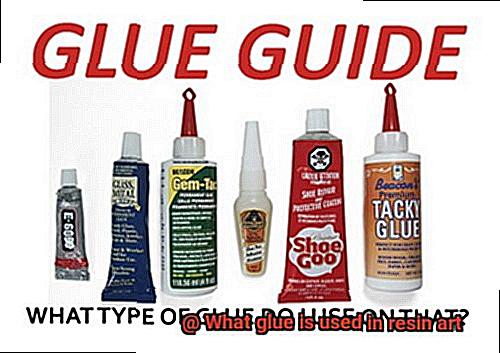
What is Resin Art?
Contents
- 1 What is Resin Art?
- 1.1 The Magic of Epoxy Resin:
- 1.2 Manipulation Techniques: Where Artistic Wizardry Begins:
- 1.3 The Illusion of Depth: A Three-Dimensional Adventure:
- 1.4 Versatility Unleashed: From Abstract Dreams to Realistic Visions:
- 1.5 The Power of Preservation: A Lasting Legacy:
- 1.6 Safety First: Embarking on a Secure Journey:
- 2 What is Epoxy Resin Glue?
- 3 Reasons Why Epoxy Resin Glue Is Favored in Resin Art
- 4 How to Select the Right Type of Epoxy Resin Glue for Your Project
- 5 Other Types of Adhesives Used in Resin Art
- 6 Benefits of Using Epoxy Resin Glue for Your Project
- 7 Considerations When Choosing an Epoxy Resin Glue
- 8 Conclusion
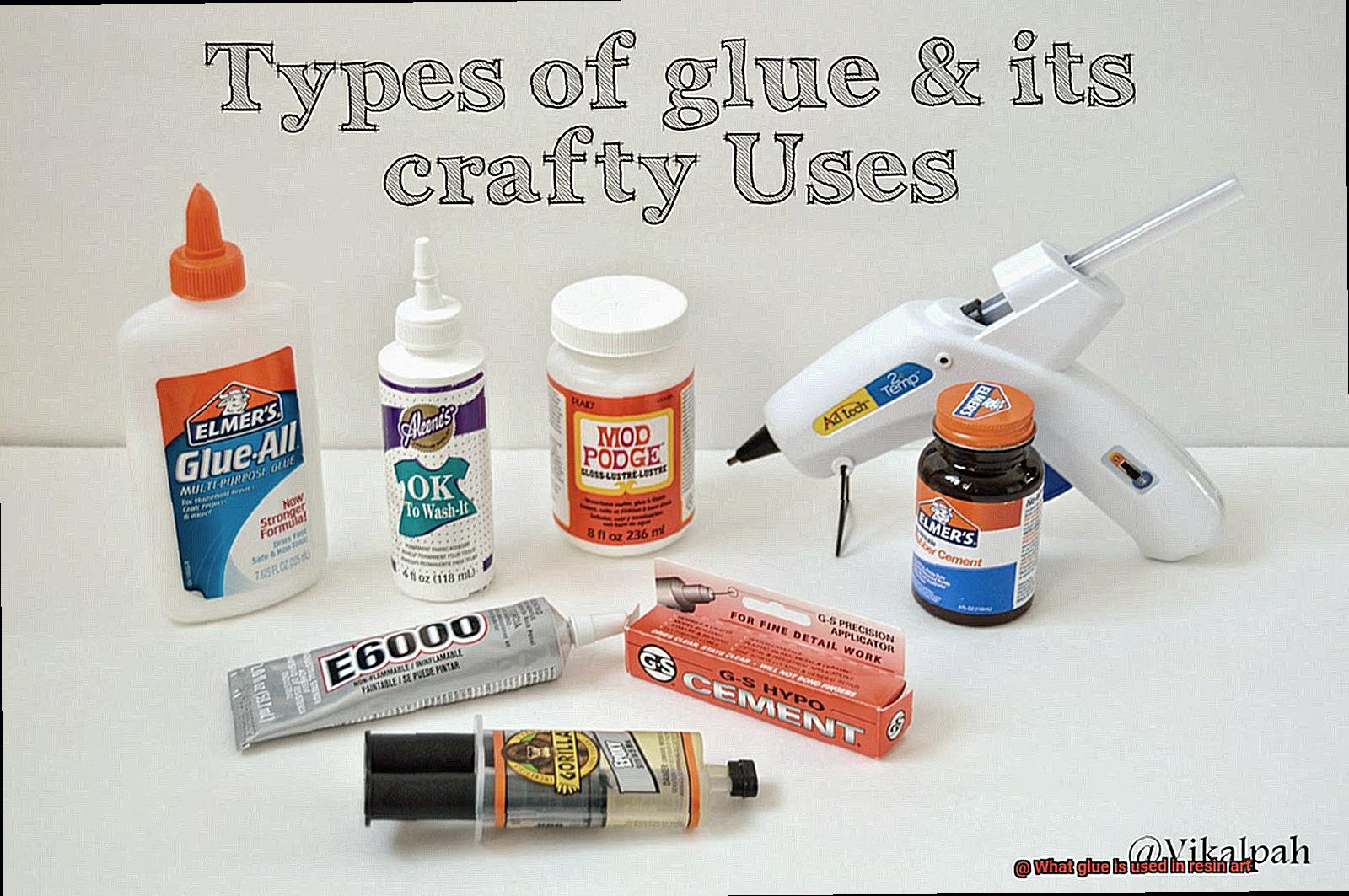
Step into the enchanting world of resin art, where creativity knows no bounds and visual effects come to life. Whether you’re an art enthusiast, a budding artist seeking new horizons, or simply curious about this captivating medium, let’s dive headfirst into the mesmerizing realm of resin art.
The Magic of Epoxy Resin:
At the heart of resin art lies the star player, epoxy resin. This remarkable two-part adhesive, when combined, undergoes a chemical reaction that transforms it into a hard, glossy masterpiece. Renowned for its durability, clarity, and self-leveling properties, epoxy resin sets the stage for an artistic journey like no other.
Manipulation Techniques: Where Artistic Wizardry Begins:
Resin artists wield a variety of techniques to manipulate the resin and create breathtaking effects. From swirling and tilting to blowing and pouring, these skilled artisans craft fluid and abstract designs that seem to dance on the canvas. To enhance their artwork further, they incorporate pigments, dyes, glitter, or even dried flowers, adding bursts of color and texture that elevate each piece to new heights.
The Illusion of Depth: A Three-Dimensional Adventure:
Prepare to be captivated by resin art’s ability to deceive the eye. As the resin cures, it magically levels itself, creating a smooth, glass-like finish that adds depth and dimension to every stroke. By layering resin, artists conjure up a sense of movement within their creations, inviting viewers on an immersive journey through their artwork.
Versatility Unleashed: From Abstract Dreams to Realistic Visions:
Resin art embraces all styles with open arms. Abstract designs burst forth with vibrant colors and fluid shapes, while landscapes transport you into a breathtaking realm of nature’s wonders. But don’t be surprised if you stumble upon resin renditions of realistic portraits that leave you in awe. The glossy finish of resin accentuates every detail, breathing life into each masterpiece and making it truly unique.
The Power of Preservation: A Lasting Legacy:
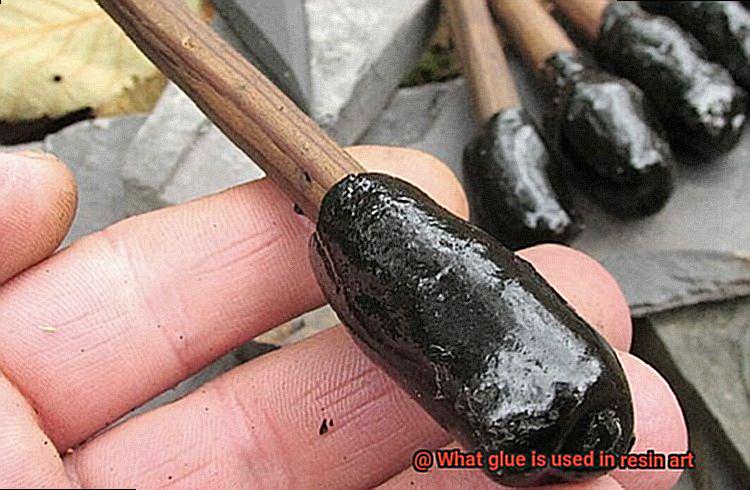
Resin art not only dazzles the eye but also stands the test of time. Once cured, epoxy resin becomes a guardian, shielding the artwork from yellowing or fading. This protective layer ensures that these artistic treasures endure for years to come. And with the ability to polish for a high-gloss finish or sand for a matte effect, artists wield complete control over the final appearance of their creations.
Safety First: Embarking on a Secure Journey:
While resin art offers boundless possibilities, safety precautions are paramount. Adequate ventilation is essential due to the fumes emitted during mixing and curing. Wearing protective gear like gloves and goggles safeguards against skin contact and eye irritation, enabling artists to embark on their creative journey with peace of mind.
What is Epoxy Resin Glue?
It’s not your ordinary glue; it’s a dynamic duo consisting of a resin and a hardener. When these two components combine in just the right proportions, they undergo a mind-boggling chemical reaction that transforms them into an unyielding bond.
Let’s delve into its extraordinary abilities. First and foremost, epoxy resin glue possesses remarkable bonding properties. It can create strong, permanent bonds between an array of materials such as wood, metal, glass, ceramics, and plastics. It’s like a versatile superhero for all your resin art projects.
Strength is another exceptional characteristic of epoxy resin glue. Once cured, it forms a tough and unwavering bond that can withstand whatever challenges come its way. Picture it as the Hulk of adhesives – capable of enduring significant stress and strain.
But that’s not all. Epoxy resin glue also boasts outstanding adhesion skills. It effortlessly adheres to both porous and non-porous surfaces, ensuring a secure attachment for your resin art masterpieces. This means it has your back whether you’re working with smooth or glossy materials.
And let’s not forget about its resistance to environmental factors. Moisture, heat, chemicals, UV radiation – you name it, epoxy resin glue can handle it. This means your art pieces will remain intact and beautiful for years to come, even if they’re displayed outdoors or exposed to harsh conditions.
Now, before you embark on your own resin art adventure, there are a few things to keep in mind. Correctly mixing the resin and hardener is crucial for proper curing, so pay attention to those proportions. Additionally, this adhesive has a short working time before it starts to harden, so work efficiently and swiftly like a ninja.
Reasons Why Epoxy Resin Glue Is Favored in Resin Art
Resin art is a captivating form of artistic expression that utilizes resin as a medium to craft breathtaking and one-of-a-kind pieces. At the heart of resin art lies the essential ingredient of epoxy resin glue, which plays a pivotal role in bringing these artworks to life. In this essay, we will explore the reasons why epoxy resin glue is favored by resin artists and delve into its enchanting properties.
Exceptional Adhesive Properties:
Epoxy resin glue possesses superhero-like abilities when it comes to bonding different materials together. Whether it’s wood, glass, metal, or plastic, this adhesive forms an unwavering and trustworthy bond, ensuring that the artwork remains intact for years to come. It’s akin to a spellbinding force that unites all elements seamlessly.
Clear and Lustrous Finish:
Imagine creating an artwork that appears as though it has been dipped in a pool of liquid glass – such is the power of epoxy resin glue. Once cured, it provides a crystal clear and glossy finish that amplifies the visual allure of the artwork. It’s like adding a touch of enchantment to every creation.
Resistance to Yellowing:
No artist desires their masterpiece to lose its vibrant colors over time. Fortunately, epoxy resin glue comes to the rescue. Unlike some other adhesives, it does not succumb to the effects of yellowing or dullness due to prolonged exposure to sunlight or UV rays. This ensures that your creation remains as vivid as when it was first crafted.
Durability and Strength:
Resin art pieces necessitate durability and strength, especially if they serve functional purposes such as coasters or tabletops. Epoxy resin glue bestows upon these artworks the robustness and rigidity required to withstand everyday use. It’s akin to donning your artwork with a suit of impenetrable armor.
Versatility and Creativity:
Resin art thrives on exploring one’s creative instincts, and epoxy resin glue serves as the perfect accomplice. It can be tinted with pigments or blended with additives to produce an array of colors, textures, and effects. It’s akin to possessing a magical potion that allows artists to weave spells of creativity and bring their imagination to life.
How to Select the Right Type of Epoxy Resin Glue for Your Project
Before you embark on your artistic journey, it’s crucial to choose the right epoxy resin glue for your project. With countless options available, this decision can be overwhelming. But fear not. This guide will navigate you through the process step by step, ensuring you make an informed choice.
Type Matters:
The first consideration is the type of epoxy resin glue required. Two main types exist: one-part and two-part epoxy resin. One-part epoxy resin is ready to use, while two-part epoxy resin necessitates mixing a resin and hardener together. If you seek a bond that’s as unyielding as your creativity, opt for the two-part option.
Time is of the Essence:
Curing time assumes paramount importance. Some epoxy resins cure swiftly, while others take their time. If you relish a leisurely pace when working, select a slower-curing epoxy resin glue. Conversely, if you’re a busy bee craving instant gratification, opt for a quick-curing adhesive.
Thickness Matters Too:
Viscosity determines whether an epoxy resin glue is thick or thin. For filling gaps or cracks, choose a thicker glue that won’t drip or sag. If you need precise placement or desire to create layers, a thinner adhesive will serve your purpose.
Material Matchmaker:
Not all epoxy resins are created equal when it comes to bonding different materials. Ensure the chosen glue is compatible with the materials you are working with – be it wood, metal, glass, or any other surface. Each material has its unique needs.
Special Features:
Sometimes, a strong bond alone is insufficient. Consider any special features required for your project. Do you need UV resistance to safeguard your artwork from fading? Or perhaps flexibility to withstand temperature changes without cracking? Seek out epoxy resin glues that possess these desired properties.
Safety First:
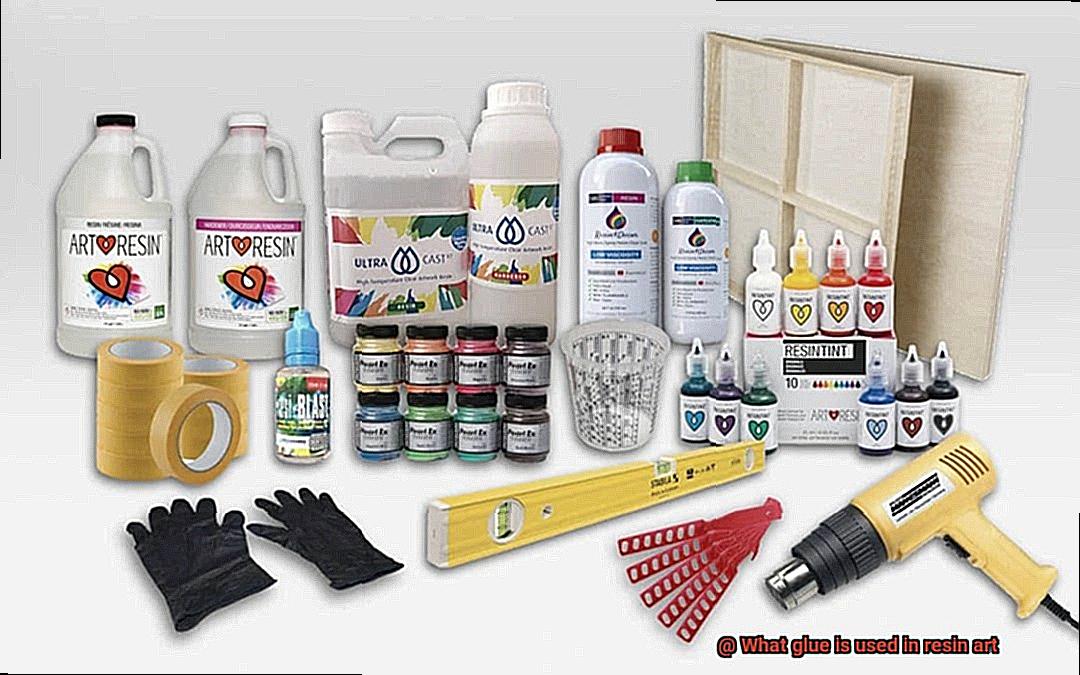
Finally, prioritize safety and the environment. Look for epoxy resin glues with low VOC or odorless formulas to maintain a pleasant workspace. Choose non-toxic and environmentally friendly options to safeguard yourself and Mother Earth.
Other Types of Adhesives Used in Resin Art
Resin art is a versatile and creative medium that allows artists to experiment with different materials and techniques. While epoxy resin is the primary adhesive used in resin art, there are several other types of adhesives that can be incorporated into artwork to achieve unique effects and secure various elements. Let’s dive into the world of adhesives in resin art and explore their properties and applications.
Polyurethane Glue:
Polyurethane glue, also known as PU glue, is a strong adhesive that bonds well to a variety of materials such as wood, metal, and plastic. It expands as it cures, filling gaps and creating a robust bond. In resin art, polyurethane glue can be used to securely attach different elements of a piece, adding structural integrity. However, it’s important to test compatibility with your specific resin before using it on a larger project.
Cyanoacrylate Glue:
Cyanoacrylate glue, or super glue, is a fast-acting adhesive that forms an instant bond. It is commonly used in resin art to attach small details or embellishments to the surface of a piece. Available in different viscosities, from thin to thick, it offers flexibility in bonding options. Handle with care as it can bond rapidly and avoid excessive skin exposure.
Hot Glue:
Hot glue guns are a staple tool in various crafts, including resin art. Hot glue provides a quick and temporary bond, making it ideal for positioning elements before permanently securing them with other adhesives. It’s particularly useful when working with lightweight embellishments or arranging objects on a canvas or substrate.
Silicone Adhesive:
Silicone adhesive is flexible, withstands high temperatures, and resists moisture – making it suitable for specific resin art applications. It serves as an excellent option for attaching objects to heat-resistant surfaces or working with resin that requires curing at higher temperatures. Silicone adhesive can be applied with a caulking gun for precise application.
Mod Podge:
Mod Podge is a popular decoupage medium that can also be used in resin art. As a water-based sealer, glue, and finish, it dries clear and adds a protective coating to artwork. Mod Podge allows artists to adhere paper, fabric, or other porous materials to the surface of resin art, adding texture and dimension.
Benefits of Using Epoxy Resin Glue for Your Project
Epoxy resin glue is a versatile adhesive that offers a multitude of benefits for your projects. Whether you’re a resin artist or simply someone looking to tackle a fun DIY project, epoxy resin glue should be at the top of your list. Its impressive bonding properties, resistance to moisture and chemicals, ease of use, and other advantages make it an ideal choice.
First and foremost, epoxy resin glue creates a bond that is not only incredibly strong but also long-lasting. Once you’ve completed your artwork or project, you can have peace of mind knowing that it will stay intact for years to come. No more worrying about pieces falling off or your creation losing its shape.
What sets epoxy resin glue apart from other adhesives is its versatility. It adheres well to a wide variety of materials, including wood, glass, metal, and even plastics. Whether you’re working on a wooden sculpture or a glass mosaic, epoxy resin glue has got you covered. You won’t need to switch between different glues for different materials – one bottle does it all.
Durability is another key advantage of using epoxy resin glue. Once cured, it forms a waterproof seal that protects your artwork from water damage and other environmental factors. This makes it perfect for outdoor projects like garden sculptures or jewelry that may come into contact with water. Additionally, it can withstand exposure to chemicals such as solvents and cleaning agents without deteriorating or losing its bond. Say goodbye to worrying about spills or accidents ruining your artwork.
Epoxy resin glue also provides a high level of clarity. When it dries, it becomes clear and transparent, allowing the colors and textures of your artwork to shine through without any cloudiness or haziness. This is especially important in resin art projects where visual impact is paramount. Your colors will pop, and your textures will be beautifully highlighted.
In terms of application, epoxy resin glue is a breeze to use. It typically comes in two parts – a resin and a hardener – that need to be mixed together before application. This gives you a designated working time to place and adjust your pieces before the glue sets. No rushing or panicking – you’re in control.
Heat resistance is another advantage of epoxy resin glue. It can withstand high temperatures without melting or losing its bond strength. This means that your artwork won’t be damaged by candles or hot beverages. You can confidently display your creations without worrying about them falling apart or losing their shape.
Additionally, epoxy resin glue comes in various viscosities, giving you the flexibility to choose the right consistency for your project. Whether you need a thin glue for delicate work or a thicker glue for filling larger gaps or cracks, epoxy resin glue has got you covered.
Considerations When Choosing an Epoxy Resin Glue
When it comes to choosing the perfect epoxy resin glue for your resin art projects, there are several important considerations to keep in mind. Let’s explore these factors in detail to ensure you make an informed decision.
Firstly, let’s talk about the type of epoxy resin glue. There are two main types available: two-part epoxy resin and one-part epoxy resin. Two-part epoxy resin requires you to mix the resin and hardener together, activating its adhesive properties. On the other hand, one-part epoxy resin comes pre-mixed and ready to use. Each type has its own advantages and disadvantages, so it’s crucial to choose the one that aligns with your project needs.
Next, consider the curing time of the epoxy resin glue. The curing time varies from a few hours to several days, depending on the specific product. If you have a time-sensitive project, opt for a fast-curing glue. However, if time is on your side, you can choose a slower-curing epoxy resin glue.
Viscosity is another crucial factor to consider. Low-viscosity glues flow easily, making them perfect for intricate details or minimal layering. In contrast, high-viscosity glues are thicker and provide better control for thicker layers or projects that require more precision.
Safety should always be a top priority when working with epoxy resins. These glues contain chemicals that can be harmful if not used properly. Follow all safety guidelines provided by the manufacturer, such as wearing protective gloves and working in a well-ventilated area. Additionally, choose a glue that aligns with your comfort level and safety precautions.
Last but not least, let’s talk about budget. Epoxy resins come in various price ranges, so consider your budget and the overall value the glue provides. Cheaper options may require more product for achieving the same results, while higher-end options might offer better performance and durability.
Gr4jeHTIsz4″ >
Also Read: How to Glue Metal to Glass?
Conclusion
Resin art wouldn’t be complete without mentioning the vital role played by glue in achieving remarkable outcomes. The go-to adhesive for most artists practicing this craft is epoxy resin – renowned for its impeccable bonding abilities and capacity to produce an exquisite glossy finish. Comprising two parts – namely the resin itself and its trusty sidekick known as hardener – this dynamic duo triggers a chemical reaction upon mixing that forms an unbreakable bond between materials like wood, glass, metal, and even fabric. Talk about versatility. Not only does epoxy resin create a bond that can withstand the test of time, but it also boasts resistance against water, heat, and chemicals – making it an ideal choice for both indoor and outdoor applications.
But wait, there’s more. Enter UV resin – the artist’s secret weapon for achieving intricate details in their resin art creations. Curing under ultraviolet light, this glue offers rapid curing times that allow artists to bring their visions to life with precision.


